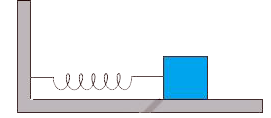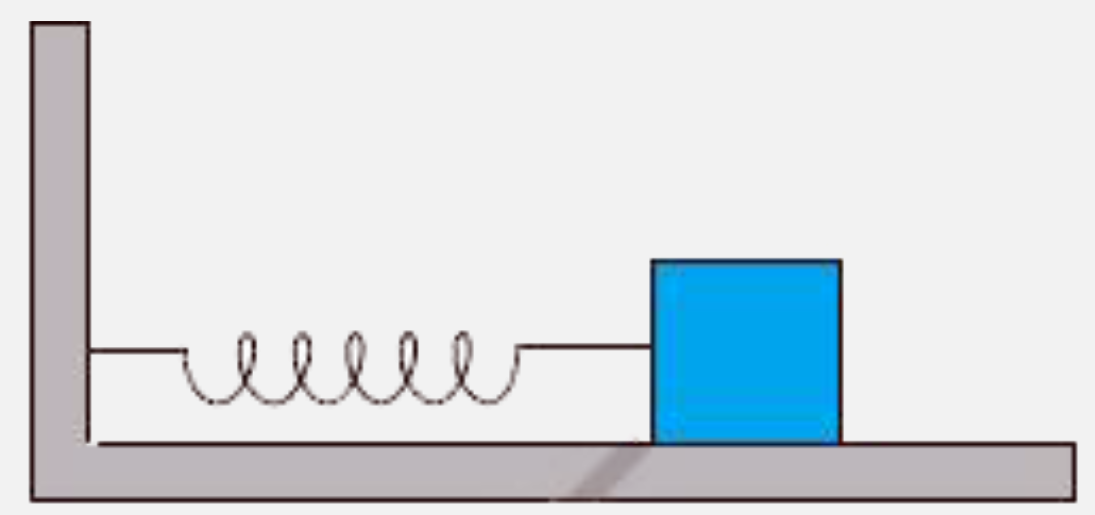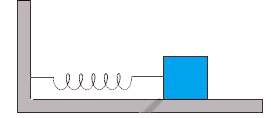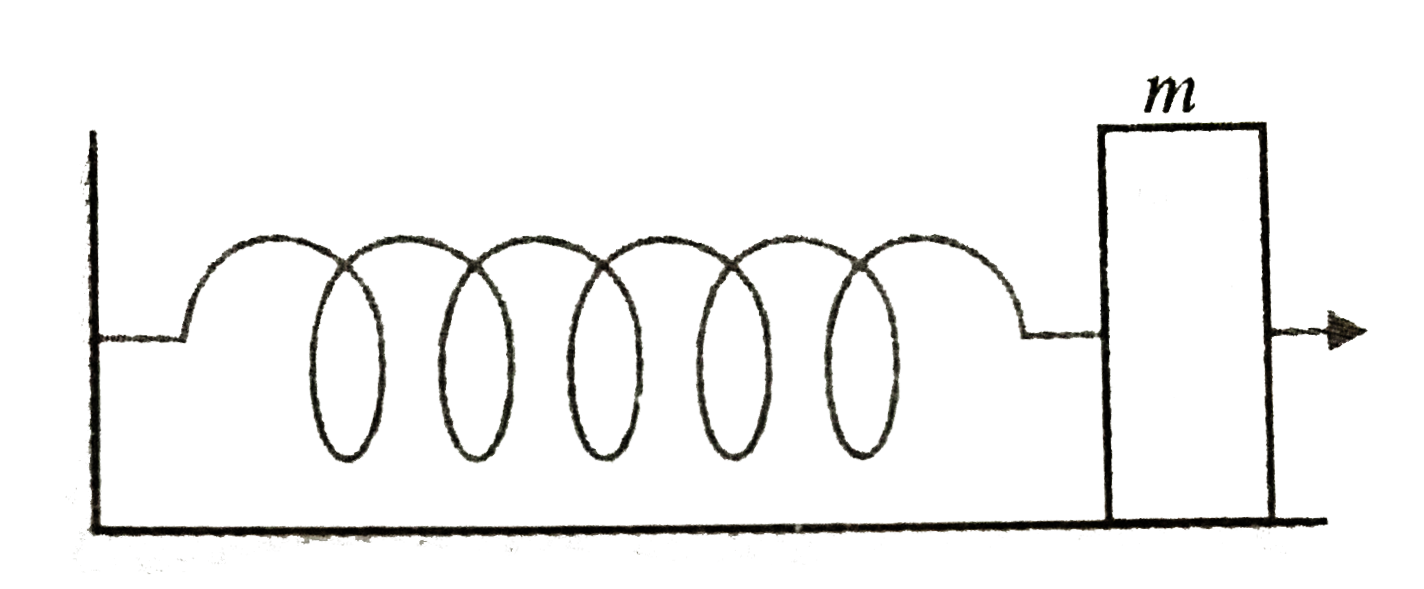A spring having with a spring constant 1200 N m–1 is mounted on a horizontal table as shown in Fig. A mass of 3 kg is attached to the free end of the spring. The mass is then pulled sideways to a distance of 2.0 cm and released.Determine i the frequency of oscillations ii maximum acceleration of the mass and iii the maximum speed of the mass.
Hence the maximum velocity of the mass is 0.4 m/s.
Related Solutions
A spring having with a spring constant is mounted on a horizontal table as shown in Fig. 14.24. A mass of 3 kg is attached to the free end of the spring. The mass is then pulled sideways to a distance of 2.0 cm and released.

Determine (i) the frequency of oscillations, (ii) maximum acceleration of the mass, and (iii) the maximum speed of the mass.
View SolutionA spring having with a spring constant is mounted on a horizontal table as shown in Fig. 14.24. A mass of 3 kg is attached to the free end of the spring. The mass is then pulled sideways to a distance of 2.0 cm and released.

Determine (i) the frequency of oscillations, (ii) maximum acceleration of the mass, and (iii) the maximum speed of the mass.
View SolutionA spring having with a spring constant 1200 N m^(-1) is mounted on a horizontal table as shown in Fig. 14.24. A mass of 3 kg is attached to the free end of the spring. The mass is then pulled sideways to a distance of 2.0 cm and released. Determine (i) the frequency of oscillations, (ii) maximum acceleration of the mass, and (iii) the maximum speed of the mass.
View SolutionA spring having with a spring constant 1200 N m^(-1) is mounted on a horizontal table as shown in Fig. 14.24. A mass of 3 kg is attached to the free end of the spring. The mass is then pulled sideways to a distance of 2.0 cm and released. Determine (i) the frequency of oscillations, (ii) maximum acceleration of the mass, and (iii) the maximum speed of the mass.
View SolutionA spring having with a spring constant 1200 N m^-1 is mounted on a horizontal table as shown in Fig. 14.24. A mass of 3 kg is attached to the free end of the spring. The mass is then pulled sideways to a distance of 2.0 cm and released.Determine maximum acceleration of the mass,
View SolutionA spring having with a spring constant 1200 N m^-1 is mounted on a horizontal table as shown in Fig. 14.24. A mass of 3 kg is attached to the free end of the spring. The mass is then pulled sideways to a distance of 2.0 cm and released.Determine the maximum speed of the mass
View SolutionA spring having with a spring constant 1200 N m^-1 is mounted on a horizontal table as shown in Fig. 14.24. A mass of 3 kg is attached to the free end of the spring. The mass is then pulled sideways to a distance of 2.0 cm and released.Determine the frequency of oscillations,
View SolutionA spring having a spring constant 1200Mn^(-1) is mounted on a horizontal table. A mass of 3 kg is attached to the free end of the spring. The mass is then pulled sideways to a distance of 0.02 m and released. Determine (i) frequency of oscillations (ii) maximum acceleration of the mass and (iii) the maximum speed of the mass.
View SolutionA 3 kg mass is attached to a spring of spring constant 1200 N/m. It is pulled sideways to a distance of 2.0 cm and released. Calculate Maximum acceleration.
View SolutionA spring having spring constant is mounted on a horizontal table as shown in figure. A mass of is attached to the free end of the spring. The mass is the pulled sideways to a distance of and released. Determine maximum acceleration of the mass.
View SolutionA 3 kg mass is attached to a spring of spring constant 1200 N/m. It is pulled sideways to a distance of 2.0 cm and released. Calculate Maximum speed
View SolutionA spring having spring constant is mounted on a horizontal table as shown in figure. A mass of is attached to the free end of the spring. The mass is the pulled sideways to a distance of and released. Determine the maximum speed of the mass.
View SolutionA spring having spring constant is mounted on a horizontal table as shown in figure. A mass of is attached to the free end of the spring. The mass is the pulled sideways to a distance of and released. Determine the frequency of oscillations.
View SolutionA spring having with a spring constant is mounted on a horizontal table as shown in Fig. 14.24. A mass of 3 kg is attached to the free end of the spring. The mass is then pulled sideways to a distance of 2.0 cm and released.

Determine (i) the frequency of oscillations, (ii) maximum acceleration of the mass, and (iii) the maximum speed of the mass.
View SolutionA spring having with a spring constant is mounted on a horizontal table as shown in Fig. 14.24. A mass of 3 kg is attached to the free end of the spring. The mass is then pulled sideways to a distance of 2.0 cm and released.

Determine (i) the frequency of oscillations, (ii) maximum acceleration of the mass, and (iii) the maximum speed of the mass.
View SolutionA spring having with a spring constant is mounted on a horizontal table as shown in Fig. 14.24. A mass of 3 kg is attached to the free end of the spring. The mass is then pulled sideways to a distance of 2.0 cm and released.

Determine (i) the frequency of oscillations, (ii) maximum acceleration of the mass, and (iii) the maximum speed of the mass.
View SolutionA spring of force constant 1200 is mounted on a horizontal table as shown in Fig.

A mass of 3.0 kg is attached to the free end of the spring, pulled side ways to a distance 2.0 cm and released. Determine the maximum acceleration of the mass.
View SolutionA spring of force constant Is mounted on a horizontal table as shown in Fig. A mass of 3.0 kg is attached to the free end of the spring, pulled side ways to a distance 2.0 cm and released. Determine

the maximum acceleration of the mass.
View SolutionA spring of force constant is mounted on a horizontal table as shown in figure. A mass of 3.0kg is attached to the free end of the spring, pulled side ways to a distance of 2.0cm and released. Determing.
(a) the frequency of oscillation of the mass.
(b) the maximum acceleration of the mass.
(c) the maximum speed of the mass.

View SolutionA spring of force constant is mounted on a horizontal table as shown in figure. A mass of 3.0kg is attached to the free end of the spring, pulled side ways to a distance of 2.0cm and released. Determing.
(a) the frequency of oscillation of the mass.
(b) the maximum acceleration of the mass.
(c) the maximum speed of the mass.

View Solution